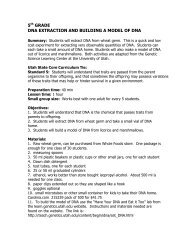1st grade how many objects does it take to sink a boat? class ...
1st grade how many objects does it take to sink a boat? class ...
1st grade how many objects does it take to sink a boat? class ...
Create successful ePaper yourself
Turn your PDF publications into a flip-book with our unique Google optimized e-Paper software.
1 ST GRADEHOW MANY OBJECTS DOES IT TAKE TO SINK A BOAT?CLASS SCIENCE FAIR PROJECTSummary: Students will work <strong>to</strong>gether as a <strong>class</strong> <strong>to</strong> generate a science fairproject. The students will use the steps of the scientific method <strong>to</strong> ask aquestion, make a hypothesis, design a test, collect data, and draw conclusions.Their findings will be presented <strong>to</strong> the <strong>class</strong> and placed on a science fair projectboard for the school science fair. The <strong>to</strong>pic of this project is <strong>to</strong> find out <strong>how</strong><strong>many</strong> <strong>objects</strong> can be placed on<strong>to</strong> a bowl <strong>boat</strong> before <strong>it</strong> <strong>sink</strong>s.Utah State Core Curriculum Tie:Standard 1: The process of science, communication of science, and thenature of scienceObjective 1: Generating EvidenceObjective 2: Communicating ScienceObjective 3: Knowing in SciencePreparation time: 30 minLesson time: 50 minSmall group size: works best w<strong>it</strong>h one adult for every 5 studentsMaterials:1. one tub per table <strong>to</strong> float the <strong>boat</strong> in2. one Styrofoam bowl per table, cut the bowl all the way around, about ¾ ofan inch above the bot<strong>to</strong>m <strong>to</strong> make a <strong>boat</strong>3. <strong>objects</strong> <strong>to</strong> place on the <strong>boat</strong> <strong>to</strong> <strong>sink</strong> <strong>it</strong>; for example, pennies or washers4. several half sheets of paper per group5. one science fair presentation board6. headings made for the presentation board: why we did this, what we thinkwill happen, <strong>how</strong> we did <strong>it</strong>, what we saw, what we learnedObjectives:1. Students will conduct an investigation that follows the scientific method.2. Students will subm<strong>it</strong> a <strong>class</strong> project <strong>to</strong> the school science fair.3. Students will perform an experiment and see if the results are reproducible.4. Students will observe <strong>how</strong> <strong>many</strong> <strong>objects</strong> can be added <strong>to</strong> a <strong>boat</strong> before <strong>it</strong><strong>sink</strong>s.Background information:A Styrofoam bowl will float on water. When <strong>objects</strong> are added <strong>to</strong> thebowl, <strong>it</strong> eventually <strong>sink</strong>s when the buoyancy of the <strong>boat</strong> is overcome by theweight that is added <strong>to</strong> <strong>it</strong>. Students will explore whether or not the samenumber of <strong>objects</strong> will <strong>sink</strong> the <strong>boat</strong> if the experiment is tried three times
Pre-lab discussion: S<strong>how</strong> the Styrofoam <strong>boat</strong> <strong>to</strong> the students and ask if theythink <strong>it</strong> will float. Discuss <strong>how</strong> <strong>many</strong> pennies they think <strong>it</strong> will <strong>take</strong> <strong>to</strong> <strong>sink</strong> the<strong>boat</strong>. Discuss the important of repeating an experiment. Ask the students ifthey think they will get the same number of pennies <strong>to</strong> <strong>sink</strong> the <strong>boat</strong> each timethey repeat the experiment. Discuss w<strong>it</strong>h students what a science fair is and tellthem that they will complete a science fair project <strong>to</strong>day in the <strong>class</strong>room.Instructional procedure:I. Experiment - Complete the experiment first and then work on the projectboard.1. Look at the <strong>objects</strong> at your table that you will use <strong>to</strong> <strong>sink</strong> the <strong>boat</strong>. Make aprediction about <strong>how</strong> <strong>many</strong> <strong>objects</strong> <strong>it</strong> will <strong>take</strong> <strong>to</strong> <strong>sink</strong> the <strong>boat</strong>.2. Put the Styrofoam <strong>boat</strong> on<strong>to</strong> the water. Take turns adding <strong>objects</strong> <strong>to</strong> the<strong>boat</strong> until <strong>it</strong> <strong>sink</strong>s. Be careful <strong>to</strong> add the <strong>objects</strong> <strong>to</strong> the center of the bowl andkeep <strong>it</strong> balanced. Try this three times <strong>to</strong> see if you get the same answer eachtime.3. Make a data table for the data, be sure and list your prediction as well as theactual values. Make a bar graph w<strong>it</strong>h the three trials on the x-axis and thenumber of <strong>objects</strong> needed <strong>to</strong> <strong>sink</strong> the <strong>boat</strong> on the y-axis.II. Science fair display board: Assign each group a different section of the<strong>class</strong> science fair display board. Each group can decide what <strong>to</strong> wr<strong>it</strong>e and thenhelp the students <strong>take</strong> turns wr<strong>it</strong>ing the different words on a half sheet of paper.Students will wr<strong>it</strong>e up their section and then place <strong>it</strong> in the appropriate area onthe display board. If you <strong>take</strong> pictures of the students working on the projectyou can put them on the board as well.
1. Why we did the project -- In a couple of sentences, wr<strong>it</strong>e the purpose of theexperiment. For example, we want <strong>to</strong> find out <strong>how</strong> <strong>many</strong> <strong>objects</strong> <strong>it</strong> <strong>take</strong>s <strong>to</strong> <strong>sink</strong>a <strong>boat</strong>. We also want <strong>to</strong> find out if we do an experiment three times, will we getthe same answer each time.2. What we think will happen – Make this prediction for each group dependingon what <strong>objects</strong> are being used <strong>to</strong> <strong>sink</strong> the <strong>boat</strong>. An example, we think that <strong>it</strong> will<strong>take</strong> 20 pennies <strong>to</strong> <strong>sink</strong> the <strong>boat</strong>. If they predict a different outcome then usetheir hypothesis.3. How we did our project -- Simplify the experiment. Put <strong>it</strong> in number forma<strong>to</strong>f no more than 3 steps.4. T<strong>it</strong>le –Make a t<strong>it</strong>le that is catchy and describes the experiment.5. What we saw – Place each group’s data table and graph on the project board.Students can also draw some pictures at the same time <strong>to</strong> add <strong>to</strong> the board.6. What we learned -- In a few sentences, explain whether our prediction wascorrect. Explain what this tells us about <strong>how</strong> <strong>many</strong> <strong>objects</strong> <strong>it</strong> <strong>take</strong>s <strong>to</strong> <strong>sink</strong> a <strong>boat</strong>and about whether we get the same answer each time we do an experiment.Display board sections:left panel center panel right panelwhy we did the project t<strong>it</strong>le what we learnedwhat we think will happentables, pictures,<strong>how</strong> we did our project drawings name of teacher



